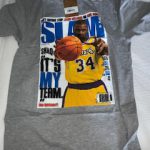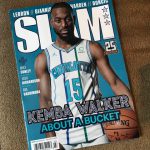By Andrew Donlan and John Alfes
Medill Reports
South Tryon Street buzzed on a summery, mid-February afternoon in Charlotte, as basketball fans from around the country swarmed a Sprinter van enveloped in vibrant magazine covers at the epicenter of the basketball universe — NBA All-Star weekend.
The van was placed strategically near Charlotte’s Mint Museum, which was paying homage to Nike’s Jordan brand in an atrium exhibit of larger-than-life graphics. The basketball staple has prevailed sans uncertainty for more than three decades. Outside, another basketball brand — the iconic SLAM Magazine — put new methods of doing business to the test, led by ambitious workers determined to propel the publication forward in its third decade, too.
SLAM, now at a 25-year milestone, engaged with the crowds in an unprecedented fashion, coasting around the bustling city of Charlotte while featuring an eye-catching display. The media outlet sold exclusive merchandise from Mitchell & Ness, distributed regular editions of its print magazine, held a dunk contest at the Puma Palace, met up with Charlotte Hornets’ guard Kemba Walker and pumped out a steady stream of digital content over its social media platforms.
Bringing awareness to the SLAM brand made the 2019 NBA All-Star festivities a roaring success in the eyes of associate editor Alex Squadron and marketing and sales associate Joshua Frohlinger.
“The van was a lot more effective and successful as a driving advertisement and billboard for SLAM,” Frohlinger said. “We did do very well in terms of merch sales, but at the end of the day, just being on the streets, everyone is seeing the van, knowing that SLAM’s presence in Charlotte was known, was very successful for us.”
By having a Sprinter van for the first time and beginning to sell apparel in just the last year, SLAM is finding different ways to connect with its audience.
“While we did sell a good amount of merch, it was more for that brand awareness,” Squadron said. “We’re driving around in this Sprinter decked out in covers, everyone’s seeing the SLAM name. I think more than anything, even if the sales weren’t jarring, the interest was clear and people were excited about the stuff we were making.”
SLAM was exclusively a magazine publication in 1994, morphing together basketball and hip-hop culture on a month-to-month basis. Since then, though, the company has cut its magazine production in half and put more of an emphasis on its social and digital material, while also creating self-branded apparel and partnering with Mitchell & Ness.
“The people are excited about our cover tees, it brings back nostalgia,” Frohlinger said of SLAM’s t-shirts that feature famous magazine covers from years past. “Our normal cover tees with Shaquille O’Neal on it or Vince Carter or Tim Duncan—people went crazy for those.”
All-Star weekend gave SLAM the opportunity to sell merchandise, shoot videos of its fans and record interviews with fan-favorite players such as Walker and Los Angeles Lakers forward Kyle Kuzma.
Even in an era where print magazines yield less influence, SLAM’s cultural perspective on the game of basketball and the weight their cover art once held gives them an advantage in the business of player access.
“The players f–k with us,” Frohlinger said. “We have that edge where it’s kind of hip. We touch every part of basketball, not just what’s on the court, but fashion, hip-hop, what the players are rocking, what’s on the feet, just all of that is the SLAM advantage. And our voice, and the way we tell that story, but then also we have access to all the players that like working with SLAM.”
The lifestyle aspect of SLAM leads to partnerships with other brands that find value in what the magazine is selling, such as Mitchell & Ness and Puma. On Saturday, it hosted a dunk contest through a partnership with the popular shoe brand.
“Puma had a three-story converted club called the Puma Palace, so we just had the dunk contest there,” Frohlinger said of the event that had lowered, 8.5-feet hoops. “That space was perfect. [Toronto Raptors guard] Danny Green was a judge, the place was packed. Kids performed really well. It was a great event.”
With the print run of magazines on the decline, SLAM Magazine is transitioning to SLAM Media. Among its new goals are to continue merchandise sales, gain more of a following on social media and partner with other brands at events.
In accomplishing such feats, SLAM hopes to pass up its biggest competitors — Bleacher Report and ESPN.
“The magazine is obviously what gave us our backbone, and what’s given us this historic brand,” Frohlinger said. “But now I think the real focus is becoming a media company to compete with these giants.”
SLAM is based in New York City, where the staff of 20 to 25 full-time employees work. Although the print magazine has shifted from monthly to bimonthly, the contents still hold a lasting value for the company’s legacy.
“We understand our magazine still has weight, which is one of the great things regardless of where the issue goes,” Squadron said. “There’s still value in [publishing the magazine], but we’ve had to move more towards digital, more towards social media, while still keeping the print going.”
Photo at top: SLAM recently began selling merchandise, using a rented Sprinter van on All-Star weekend to spread the word. (Andrew Donlan/MEDILL)









